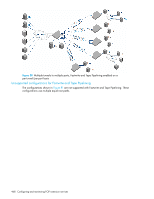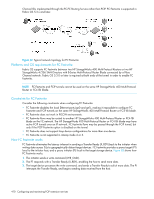HP StorageWorks 8/80 HP StorageWorks Fabric OS 6.2 administrator guide (5697-0 - Page 475
FC Fastwrite flow configuration requirements, Hardware considerations for FC Fastwrite, Configuring
 |
View all HP StorageWorks 8/80 manuals
Add to My Manuals
Save this manual to your list of manuals |
Page 475 highlights
4. The PI continues to stage data received from the initiator, respond locally to a Transfer Ready, and send the data to the target device until the target device sends a Response (FCP_RSP). Figure 83 How FC Fastwrite works FC Fastwrite can improve write performance. Read performance is unaffected. The gains seen from enabling FC Fastwrite depend on several factors, including the following: • The size of I/O versus Transfer Ready (Tx_RDY). In general, the more times a target device sends a Tx_RDY, the greater the performance gain. • The number of outstanding I/Os, both read and write, link speed, and link congestion. FC Fastwrite may not result in significant improvement if these factors suggest that the write data is delayed because it is sharing bandwidth. • Target response latency-If the target is slow in responding to the write command, the data must be held by the remote switch. FC Fastwrite flow configuration requirements Because FC Fastwrite is enabled on both initiator and target ports there is a possibility that either initiator or target ports may have flows with other devices that do not support FC Fastwrite. Therefore an FC Fastwrite-specific zone configuration is used to filter FC Fastwrite flows. Hardware considerations for FC Fastwrite FC Fastwrite is implemented in a hardware configuration consisting of two HP StorageWorks 400 Multi-Protocol Router, or two HP StorageWorks 4/256 SAN Director, or two HP StorageWorks DC SAN Backbone Director or HP StorageWorks DC04 SAN Director Switch enterprise-class platforms with B-Series Multi-Protocol Router Blades connected by Fibre Channel ISLs. Consider the following hardware characteristics and requirements when planning to implement FC Fastwrite: • FC ports on both the HP StorageWorks 400 Multi-Protocol Router and the B-Series Multi-Protocol Router Blade are organized into two groups. Ports 0-7 form one group, and ports 8-15 form the other. A maximum of four ports in each group may be configured as FC Fastwrite. • The maximum bandwidth available for FC Fastwrite is 4 Gb/s per group. This bandwidth is shared by all write flows. • Host initiators and target devices must be directly connected to the HP StorageWorks 400 Multi-Protocol Router or B-Series Multi-Protocol Router Blade on their respective ends of the ISL. FC Fastwrite must be configured and enabled for the ports on both ends of the flow. Mismatch of the configuration results in I/O failure. Configuring and enabling FC Fastwrite The FC-FC Routing Service provides Fibre Channel routing between two or more fabrics without merging those fabrics. The FC-FC Routing Service can be simultaneously used as a Fibre Channel router and for SAN extension over wide area networks (WANs) using FCIP. Fabric OS 6.2 administrator guide 471















